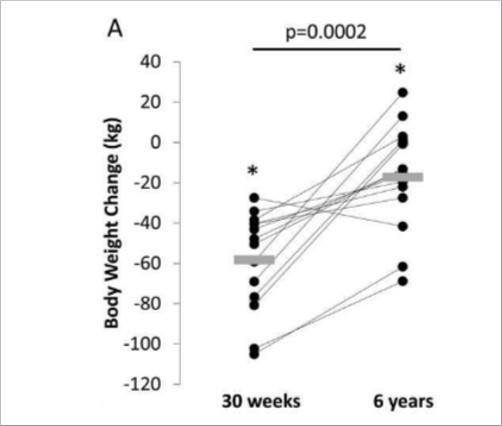Long-term weight loss is hard to maintain.
Studies show that weight loss reduces the number of calories you burn at rest, resulting in slower weight loss and faster weight regain.
A new study checked in on former contestants of The Biggest Loser TV show, and the findings were recently published in Obesity.

Background
The Biggest Loser is a popular reality TV show. It uses an “eat less, move more” approach to help obese participants lose large amounts of weight.
Participants are encouraged to eat a very-low-calorie diet. They also follow a strict exercise regimen, exercising for several hours a day on most days.
While The Biggest Loser may be an effective way to lose weight, there are some downsides to rapid weight loss using extreme calorie restriction and exercise.
One of them is adaptive thermogenesis, often referred to as metabolic adaptation or starvation mode.
Metabolic adaptation is the brain’s natural, physiological response to reduced calorie intake for long periods of time. In order to maintain energy balance and prevent starvation, the body responds by reducing calorie expenditure.
This is known as metabolic slowdown. And although it’s a well-known phenomenon accepted by scientists, how it works is still unclear.
Article Reviewed
This observational study investigated changes in resting metabolic rate and body composition 6 years after participants lost a large amount of weight.
Persistent metabolic adaptation 6 years after The Biggest Loser competition.
Study Design
This study involved participants from The Biggest Loser competitors in Season 8.
It was a follow-up study to a previous study, which examined whether The Biggest Loser weight loss program helped preserve lean mass and maintain resting metabolic rate.
Out of the 16 participants in the original study, 14 participated in the follow-up that took place 6 years after the weight loss competition ended. This time, the researchers looked into changes in resting metabolic rate and body composition.
For two weeks before the follow-up measurements, body weight was monitored daily.
The participants then stayed at a clinical center for three days. During that time, the researchers measured several factors, including body weight and composition, resting metabolic rate and total energy expenditure.
Blood samples were also collected after an overnight fast, to measure blood sugar, insulin, blood lipids, leptin and several other hormones.
These measurements were then compared to data collected at the beginning and the end of the 30-week competition in 2009.
Bottom Line: This follow-up study examined the changes in resting metabolic rate and body composition 6 years after extreme weight loss.
Finding 1: Contestants Regained a Significant Amount of the Weight They’d Lost
Of the 14 participants who took part in the follow-up study, 13 regained weight within 6 years.
What’s more, four contestants are heavier today than before they took part in The Biggest Loser. Only one contestant weighs less now than 6 years ago.
These findings are shown in the figure below.

However, despite this weight regain, the researchers concluded that compared to other dieting methods the contestants were quite successful at long-term weight loss.
Bottom Line: Most of the contestants regained weight in the years following their extreme weight loss. Only one participant currently weighs less.
Finding 2: Metabolic Adaptation Persists Over Time
Resting metabolic rate (RMR) remained low, as it was 6 years earlier when the competition ended. This is despite substantial weight regain.
That means that to maintain their weight, participants must consume fewer calories.
The average calories burned at rest were around 500 calories lower per day than expected based on current weight and age.

Bottom Line: The contestants had unusually slow metabolisms 6 years after the competition, making long-term weight maintenance difficult.
Limitations
The study had several limitations. First, it did not include a control group of obese people who did not lose weight.
Second, the subjects in this study were obese, which makes the results hard to translate to the general public.
Third, the results are hard to compare to more typical weight loss programs due to the extreme nature of The Biggest Loser.
Lastly, the study was very small, which limits statistical power.
Bottom Line: This study was small, didn’t include a control group and may not apply to non-obese people or those following a less extreme program.
Summary and Real-Life Application
In short, this study found that contestants of The Biggest Loser had slow metabolisms for their size 6 years after the show ended.
This made it difficult for them to maintain weight loss, and almost all of the participants had put a significant amount of weight back on.
Unfortunately, there is no known way to completely prevent metabolic slowdown.
However, doing some form of resistance training, like weight lifting, can at least partly reduce muscle loss and metabolic slowdown during weight loss. Eating a high-protein diet may also help.